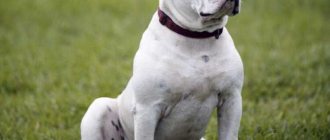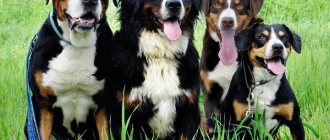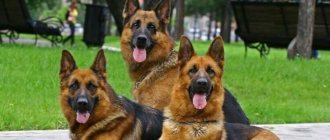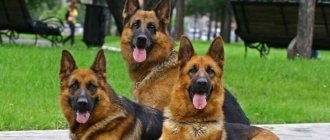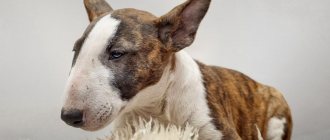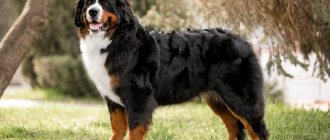Review author: “ZooVita”
Bernese Mountain Dogs originate from Switzerland, where they are highly valued not only as companions and pets, but also as working dogs. In their homeland, they are classified as Mountain Dogs and are known as true gentle giants, especially good with children of all ages.
Breed characteristics
| Short description | |
| Origin: | Switzerland |
| Conditions of detention: | Free enclosure, in a house with a garden, in a house with a small garden, in a large apartment |
| Purpose: | Shepherd dog, nanny dog |
| Color: | Tricolor, base black with spots of red and white |
| Wool length: | Medium, dense undercoat |
| Adult dog size: | Males reach 64-70 cm at the withers, females 58-66 cm. Males weigh 35-55 kg, females weigh 35-45 kg |
| Average life expectancy: | 8-10 years |
| Walk: | Once or twice a day |
| Physical activity needs: | Medium – an adult dog needs two hours of active walks a day |
| Fédération Cynologique Internationale (FIC) classification: | Group 2: Pinschers and Schnauzers, Molosser Mountain Dogs and Swiss Cattle Dogs; Section 2: Swiss Mountain and Cattle Dogs |
| Puppy price: | 25,000 to 40,000 rubles |
History of the origin of the Bernese Mountain Dog
One of the main versions of the origin of the Bernese Mountain Dog breed is the existence of this type of dog back in the days of the Roman Empire.
The Bernese Mountain Dog breed originates in the Alps, so the name of this breed is literally translated as “ alpine meadow dog .” They were actively used as herding dogs for herds. However, the Bernese Mountain Dog is not at all suitable for home guarding.
The breed standard and name was first introduced by Albert Heim in 1908. Over time, this breed has established itself beyond its native country and gained recognition in other countries.
The Bernese Mountain Dog appeared in Russia in 1989 and the popularity of the breed is still growing.
Distinctive features of the Bernese Mountain Dog
The main distinguishing features from other varieties of the Mountain Dog breed are the following:
- The coat is long, single-layered, with a bright shine.
- Torso. This is a fairly large, dense breed, with a proportional body and well-developed muscles.
- The head is not too large, but powerful.
- The neck is thick and quite long.
- The lips are compressed and there is no salivation.
- The eyes are small brown, almond-shaped, widely set.
- The ears are medium-sized, triangular in shape, they are lowered down when the dog is calm, and raised when the animal is alert and interested in something.
- The tail is long and fluffy, tapering towards the end.
- The legs are strong and muscular, which contributes to the dog's great endurance.
Photo of an adult dog
Photos of puppies
Features of character and behavior
The dog's bright appearance and character attracted the attention of many dog breeders . Burns is an affectionate, good-natured and calm family companion. However, at a young age, before reaching 3 years of age, the puppy is very active and mobile. Raising and timely training of a dog will help to correctly form the dog’s character in the future.
Advantages
- Despite their gigantic size, Bernese Mountain Dogs have a patient and good-natured character.
- One of the main advantages of Burns's character is loyalty; it is very important for a dog to be useful to its owner, so they want to please people in almost everything.
- In addition, the Bernese Mountain Dog has a friendly character and loves all family members, especially children.
Flaws
All positive and friendly character traits are inherent in the Bernese Mountain Dog if it is properly raised by its owner. If mistakes were made in the educational process, then aggressive behavior may be observed in dogs, especially males.
It should be borne in mind that the process of training a Bernese Mountain Dog requires a lot of patience, effort and time. Despite the fact that dogs of this breed love to please their owner, they do not have the qualities required for quick learning. A dog needs time to understand what is required and wanted from it.
Also, one of the negative character traits of Burns is their laziness; they are ready to spend a lot of energy for very little time. They like to spend most of their time next to people and take part in their work. Although for many dog owners, especially those leading a moderate, less active lifestyle, this is not a bad character trait. But lovers of large working dogs, who require stamina and energy from their pet, will be more likely to be disappointed than pleased by the laziness of the animal.
Application
The Bernese Mountain Dog (pictured) has saved more than one human life
Despite the initial use of these dogs for herding herds, guarding and working in sleds, today they are primarily a companion dog.
However, representatives of the breed are widely used in rescue operations in the mountains or at disaster sites. Apparently, the Newfoundland genes are at work.
Dogs also work in the police, like Hovawarts and Groenendaels . Their excellent instincts make them excellent detectives. They are excellent at agility and achieve success in guard duty and protective training.
Important! The Bernese Mountain Dog is a great dog for families with small children. A brave, smart and intelligent friend will gladly offer his mighty back to a child who is just learning to walk.
Thanks to their versatility, representatives of the breed have become real movie stars, starring in many feature films and commercials.
Care and maintenance
- A suitable place to keep a Bernese Mountain Dog is an aviary. The dog is quite adequate to the chain, which should allow the animal to move no less than 10 square meters. This way the dog will feel good and comfortable.
- One of the features of caring for the Bernese Mountain Dog is the pet’s need for constant care and attention from the owner. If there is a lack of care, the pet may develop a depressive state.
- The basis of caring for your Bernese Mountain Dog is regular brushing of its coat. Since dogs of this breed shed a lot and constantly, they are not suitable for people suffering from an allergic reaction to wool.
- It is necessary to regularly monitor the cleanliness of your pet's eyes, teeth and ears , as dirt and germs can accumulate in them, which can lead to inflammatory processes. To prevent inflammation, following simple rules of hygiene and pet care will help.
- You should take care of your dog's nails by trimming them regularly. If you don’t have the skills to trim your nails yourself, you can contact a veterinary clinic specialist.
Nutrition
The Bernese Mountain Dog has an excellent appetite, which is clearly evident from its large size. Accordingly, the owner of this breed needs to support and give the dog a decent amount of food necessary to maintain the growth and development of the animal.
The following products should be included in the complex of natural dishes:
- Meat;
- Cereals;
- Vegetables, boiled or raw;
- Dairy products;
- Low-fat sea fish in small quantities.
It is also recommended to give your dog a raw chicken egg, but it is allowed 1 or 2 times a week.
It should be borne in mind that from pieces of meat it is better for a dog to choose the most sinewy, containing cartilage and tripe. This helps strengthen ligaments and has a beneficial effect on the functioning of the gastrointestinal tract.
If you feed your pet a ready-made diet, you should choose low-fat products. The large body weight of dogs of this breed and their inactive lifestyle can lead to obesity.
It is especially important, with any type of feeding, to monitor your pet’s drinking regime. There must be constant access to clean water in unlimited quantities.
When choosing vitamin complexes for a dog, it is recommended to consult a veterinarian and not select the drug yourself.
At any age, a dog needs proper and nutritious nutrition, because this is the key to the animal’s health.
The puppy should be fed in small portions 5-6 times a day , gradually increasing the portion size and reducing the amount of food consumed. From the age of one year the dog is fed twice a day.
Health
Like any animal, the Bernese Mountain Dog is susceptible to developing various diseases . It should be borne in mind that recently there has been a decrease in the average life expectancy of Burns, from approximately 10-12 years to 6-8 .
It is important to pay attention to your pet's health and visit the veterinarian more often. At the first symptoms of the disease, seek qualified help.
Vaccinations
It should be borne in mind that the health of a pet depends on the care and attention of its owner.
Even at a young age, it is necessary to take care of the dog’s health and vaccinate the puppy:
- The first vaccination is prescribed when the pet is two months old. The drug is aimed at protecting against hepatitis, leptospirosis, and parovirus enteritis.
- At six months and a year, comprehensive vaccination is performed , including a rabies vaccination, which should then be performed annually.
Vaccination must be carried out according to the age schedule, which will be advised by the veterinarian.
Before vaccination, your pet should be given anthelmintic drugs, after consulting with a specialist.
It should be taken into account that there are restrictions on vaccination, namely, when a dog’s teeth change, vaccination cannot be given, since the pet’s body is weakened.
Diseases
The most common diseases found in Bernese Mountain Dogs are:
- Bloating;
- Dysplasia of the hip or elbow joints;
- Osteochondrosis of the shoulder;
- Cataract;
- inversion of eyelids;
- Oncological process.
Unfortunately, Burns are considered a weak breed.
Regular and long walks, good nutrition, attention and proper care of the pet contribute to the pet’s good health for many years.
Walk
- Burns does not require a lot of physical activity. If the animal is on a chain, the dog requires regular walks, at least two hours a day. The same applies if the dog is kept in apartment conditions.
- Walking is required at least twice a day . At the same time, it is necessary to pay attention to outdoor games and running, however, for a very short time. The Bernese Mountain Dog prefers the attention of its owner and spending quiet time with him.
Possible diseases
Unfortunately, the “Swiss” has a short life expectancy (about 10-11 years) and is prone to the following diseases:
— An allergy is a painful reaction of the body to an allergen.
— Dysplasia is a disease of cartilage tissue that causes deformation of joints or disruption of their integrity. It usually has a hereditary origin - when purchasing a puppy, you should ask for a medical certificate about the health of its parents.
- Osteochondrosis - various destructions of cartilage tissue due to various dystrophies. It usually affects the shoulder musculoskeletal system.
— Entropion is the turn of the century. Deformation of the eyelid line, due to which the eyelashes cause irritation of the mucous membrane and damage to the eyeball.
- Eye diseases - cataracts, retinal atrophy.
— Oncological diseases (are hereditary in nature).
Grooming
- The Bernese Mountain Dog sheds heavily all year round. Therefore, caring for your pet's coat is a must. This will help keep the house clean if the dog is in an apartment, and alleviate the pet’s condition.
- For grooming purposes, the Bernese Mountain Dog requires brushing once every two weeks . During periods of increased shedding, brushing should be done at least once a week. During hot weather, it is recommended to brush your dog daily. For combing, you can use a special comb for animals - a furminator.
- Tangled areas of fur can be trimmed, however, you should not get carried away with this process. Frequent clipping of the coat can be harmful, so it is best to avoid the formation of clumps of dirty and matted fur.
Psychology
A dog with a stable psyche, calm and unobtrusive in the house. The pride of the representatives of the breed does not allow Bernese Mountain Dogs to ask for their master's affection and attention.
They do not accept physical punishment at all. You can control a dog only with the help of the established authority of the owner.
The attitude towards animals and children develops with a hint of condescension. These dogs, like German Boxers , get along easily with other pets.
Despite all of the above, a calm Bernese without the slightest delay is capable, like a fighting dog , of turning into a fearless and ferocious defender if the owner, his family or property is in danger.
Mating
It should be taken into account that mating must be carried out until both the male and female Bernese Mountain Dogs are no later than three years old. Otherwise, the animal may lose interest in mating.
The first heat in bitches is observed at one year of age . The best time for mating is considered to be 10-13 days after the start of estrus. A bitch's readiness for mating can be determined by stroking her back, if the dog moves her tail to the side.
When choosing a pair, you need to pay attention to the following points:
- Temperament;
- Health;
- Pedigree;
- Compliance with breed standards.
It is recommended to carry out mating on the male dog’s territory so that he feels freer. Don't rush the dogs; they need time to get used to each other.
A day or two after the first mating, a control mating should be carried out, since there is no guarantee of a successful result.
Walk
Particular attention should be paid to physical activity. Unlike similar dog breeds, the Bernese does not need a large number of them.
You can just take a long walk with your pet, go for light jogs from time to time, and play with him.
Important! For the Bernese Mountain Dog, the main thing is the company of the owner and his attention. No matter how energetic your walks are, the most important thing is that you are nearby.
The game with a stick, shown in the photo, is one of the favorites of this breed.
Key points in training
- The Burns are relaxed about training. However, these friendly dogs will be more flexible and will complete tasks faster with tasty encouragement, stroking and kind words than with rudeness addressed to them.
- The sooner you start training your puppy, the better it will be for both the dog and the owner . First of all, the puppy should be weaned from unexpected attacks on family members. This is not so noticeable at the age of the puppy, but it will be significantly felt when the pet grows up and becomes a big dog.
- It is especially worth paying attention to the period of disobedience and pranks - 4-8 months of the puppy . Be sure to accustom your pet to wearing a collar and to following simple commands - “ Come to me!” ", " Fu " and others.
- Professional training and training should be carried out in a special club under the guidance of professionals . Complex types of training should only be carried out when the dog is two years old.
- Read about how to properly train a dog in the article: “Training a puppy: effective methods from dog handlers, learning commands at home.”
You shouldn’t expect miracles from your Bernese Mountain Dog when training. The main thing is to be patient, since a pet of this breed will need a lot of time to understand what exactly they want from him.
Representatives of this breed have a positive attitude towards training, and moreover, they need it. Classes and training must be systematic.
Reviews from Bern owners
“As a puppy, our Maggie quickly learned not to dirty the house, and since then she continues to amaze us with her intelligence. Allows the youngest to hold on to the fur, licks his legs. He plays tug of war with his adult daughter, brings fetch, sometimes they just run around the site together. Our family would not be complete without this dog, I don’t know how to explain.”
“I lived with a Bern, and I can say that this is the best dog of all. Byron was a calm, obedient dog. Kind as a felt boot. He got along with cats and adored children. Veta was afraid like fire - he would come to give vaccinations, and this carcass was hiding behind me, they laughed until they cried. Only he lived only 7 years. Shoulder sarcoma, nothing could be done. Now I'm afraid to get a dog of the same breed - maybe again. It was too bitter to part."
“Bern is a giant teddy bear! My affectionate as a cat, I have never noticed any signs of aggression towards anyone. He pushes around when he plays, it’s terrible, but how can you be angry with him? We took our Gordon with a faulty color - cheaper than others, what difference does it make to us. I've had a lot of trouble with wool, it's everywhere. But this is the only disadvantage of the breed."
“This is my first dog that guesses my mood and reacts to the slightest gestures. A true empath, a devoted friend. It seems that he loves his wife too, but I feel that this is my dog. He ruined our entire garden - he tramples the beds, breaks the bushes, digs. Even so, the neighbors are vying with each other to ask when Tyson will have puppies.”
“It was scary to take such a big dog into the apartment, but we just couldn’t resist! Now our Alpha is three years old and most of the time he sleeps and does not shine. Maybe we came across such a fool, but the repairs are intact, the dog is content with two long walks, everyone is happy.”


